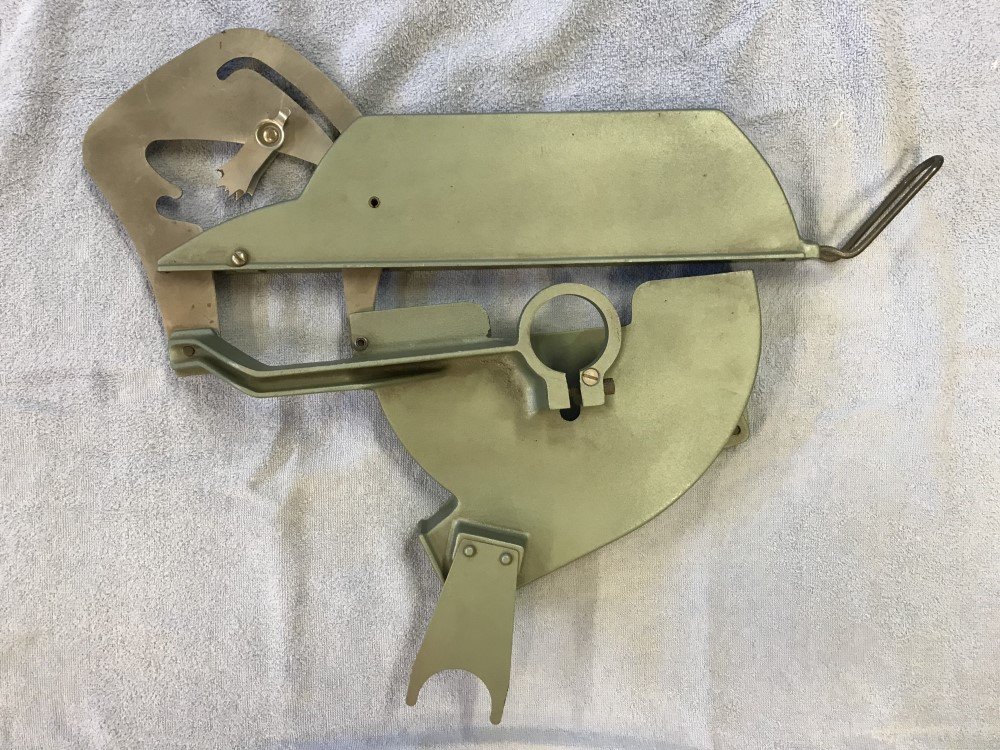The Disk Sander is easy to come by and there is a couple of choices. The early Mark 5 came with an Aluminum 12" Sanding Disk while those made in the 1970's or later have the Steel 12" Sanding Disk. The other models of the Mark V use a Steel Sanding Disk with a longer hub. Any of these Sanding Disks will work for your 2 Mark 5's. If you plan to do a lot of Disk Sanding, I recommend getting the Sanding Disk Dust Chute made for the Mark V 500. That needs a Steel Sanding Disk. The Aluminum Sanding Disk will not work in it due to clearance issues. The Sanding Disk Dust Chute is a stripped-down version of the Lower Saw Blade Guard for the Mark V 510/505, 520, 520S, Mark 7 and 4. It is below.
_

- 555167 DustChute.jpg (6.15 KiB) Viewed 30199 times
.
As for Saw Blade Guard sets for your Mark 5's there are several choices. The first Guard set made for the Mark 5 is one I would not recommend. It was made for only up to 9" Saw Blades and is harder to find anyway. It is below in the Greenie paint.
_

- 22 370.jpg (223.19 KiB) Viewed 30199 times
.
The one from the era your later Mark 5 was made is the set shown below.
_

- 505627 Upper and 505628 Lower Saw Blade Guards r.jpg (85.54 KiB) Viewed 30199 times
.
It is the simplest one to attach and set up. Many do not like it due to the Upper Guard being made of metal as opposed to plastic that can be seen through. If considering buying this one do watch out that it has all the parts shown above. It is commonly sold as the upper or lower guard separately. The Shoe, as it is called, is the heavy wire loop on the front of the Upper Guard that lifts the guard up over the stock and is often missing. It cannot be used without it. Sometimes the post on the bottom of the lower guard is missing but can be used without it. The post is for alignment of the Guard set and rests against the rear Way Tube. Once it is aligned with the Saw Blade it can be removed and re-installed by simply un-clamping or clamping it to the Quill end.
Lastly is the Belt Sander you are interested in. If buying used there are things to watch out for. Some wear is easy to fix, like replacing the
I have this guard set that I use but not on a Mark. It also makes a great guard set for the Model 10E and 10ER. It adds dust collection to my Model 10's and a simpler upper guard to use since it is attached to the lower guard as opposed to the Table for the original Upper Saw Blade Guard for the Model 10's.
The other remaining Guard set and had 2 versions. The original version had a single 1-1/4" diameter dust port shown below.
_

- 505875 V1 500 Saw Blade Guard Assembly 1980s r.jpg (102.66 KiB) Viewed 30199 times
.
Below is the later version with two 2-1/2" diameter dust ports. There was also an upgrade kit to convert the single 1-1/4" dust port to the two 2-1/2" dust ports.
_

- 505875 V2 500 Saw Blade Guard Assembly.jpg (17.37 KiB) Viewed 30199 times
.
This later guard set is more involved for installing and use. It requires holes drilled and tapped in the Table Assembly. When installing for use the upper guard must be aligned to the blade each time.
Lastly there is the Belt Sander you are interested in. There are two different Belt Sanders. The first being the 6" Belt Sander. If buying used there are things to watch out for. Some wear items are easy and inexpensive to fix, like replacing the Drive Sleeve on the Drive Drum, while other are more expensive repairs. If possible, have the seller demonstrate it in use. Make sure the belt tracks properly and with the correct tension. Having to replace the upper Idler Drum Assembly will add significantly to the final price of the Belt Sander. Look for damage to the unit from tracking problems like "grinding" away at the sides. It's an indication of problems with the tracking adjustment parts including the Idler Drum or an operator that wasn't able to get it properly set to track correctly.
The other Belt Sander is the Strip Sander which uses 1' and 1/2" wide belts. It is easier to set up and use than the 6" Belt Sander.
Look at the type of Belt Sanding you plan to do to decide which one is best. Maybe both would be helpful in your collection of tools as they provide different ranges of sanding using belts. I have and do use both.